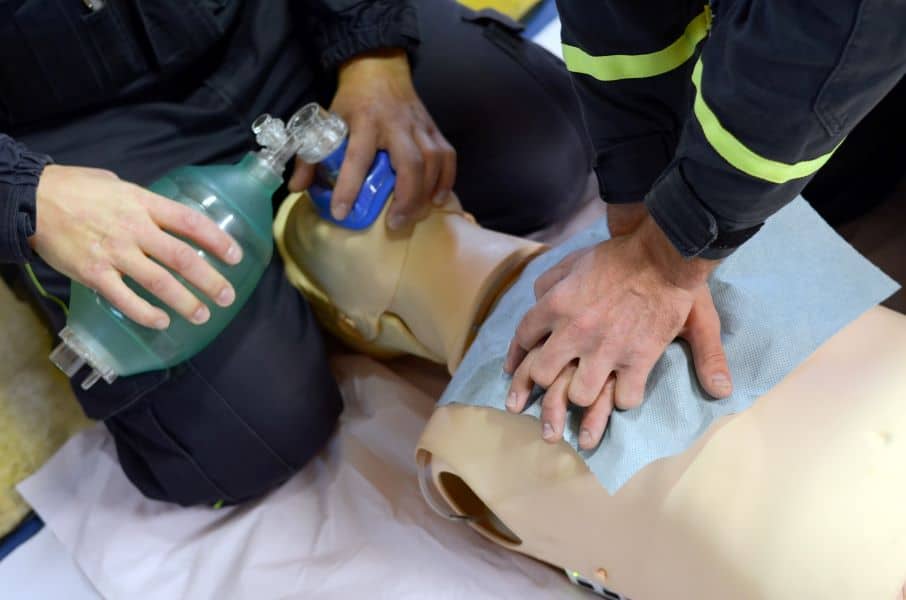In assessing the framework for emergency response training, it’s imperative to recognise the diverse nature of requirements across various sectors.
Our examination of these stipulations reveals a core focus on ensuring that all personnel are equipped with both theoretical knowledge and practical skills to respond effectively in emergency situations.
A pivotal piece of these training requirements is the adherence to the Australian Standards for Training (AS 3745-2010). This entails a thorough induction in Emergency Control Organisation and Procedures for Buildings.
You must ensure that emergency control personnel and emergency response teams in my facility are competent. Mandatory components include:
- Evacuation coordination
- Emergency plan management
- Use of firefighting equipment
- First aid proficiency
Moreover, you will often engage with industry-specific guidelines, which dictate the nuances of training according to the particular risks present.
For instance, in the chemical processing industry, your training must encompass hazard recognition, spill control, and containment measures beyond the standard protocols. Conversely, in a corporate office environment, your focus shifts to evacuation procedures and communication systems.
In line with the Work Health and Safety Act 2011, we will ensure that your training is not only up-to-date but also periodically reviewed.
To ensure continuous improvement, we integrate simulations and drills to benchmark my readiness against dynamic and challenging scenarios.
From Compliance to Competence
In emergency response training, we recognise the importance of evolving from mere regulatory compliance to a focus on genuine competence. This transition cultivates a workforce that is not only trained but truly prepared to handle emergencies.
Understanding the Shift
We have observed that historically, emergency response training was heavily geared towards meeting legal and procedural minimums. Now, there is an emphasis on ensuring individuals possess the skills and judgement needed to effectively manage crises.
This shift acknowledges that strict adherence to protocol may not suffice when unpredictable situations arise in the field. Workers must demonstrate critical thinking, adaptability, and decision-making skills that go beyond what’s written in manuals.
Assessing Current Training Practices
By examining present training methods, we discern several areas where compliance-focused strategies are still prevalent.
Some organisations maintain a checklist approach, which, while satisfying statutory requirements, does not guarantee that employees can effectively apply their knowledge in real-world scenarios.
Our assessment involves looking at training content, delivery methods, and evaluation processes to understand how they contribute to actual preparedness.
Identifying Competence-Based Goals
Setting competence-based goals requires clarity about the skills and behaviours that enable effective emergency response.
We identify core competencies such as situational awareness, communication, leadership, and technical proficiency specific to the emergency context.
These elements should form the basis of training objectives, with a clear progression from basic to advanced applications. Becoming competent means responders can confidently adapt their actions to suit the unique demands of each incident they may face.
Unravelling Our Emergency Response Training Requirements
Understanding your emergency response training requirements involves a comprehensive review of legal standards and a commitment to translate those standards into actionable competencies. Our goal is to detail the framework we have used to achieve both compliance and practical proficiency.
Mapping Out Legal Obligations
Our first step was to meticulously catalogue all pertinent legislation and industry guidelines related to emergency response. This required a thorough examination of documents such as the Australian Standards for Occupational Health and Safety, the Work Health and Safety Act 2011, and various industry-specific requirements.
By laying out these obligations side by side, we can see where our training program needs to direct its focus.
It was imperative to ensure that not only were we meeting the letter of the law but that the intent behind each requirement was integrated into our practices.
Bridging the Gap Between Compliance and Competence
Next, we work to ensure that our compliance with legislative mandates was not merely a box-ticking exercise.
The crux of the matter lay in bridging the instructional gap between what was legally required and what would be practically applied in an emergency scenario.
To do this, we have conducted skills gap analyses to determine where our team’s capabilities could be strengthened.
It was not enough simply to be compliant; it was essential to develop real-world competencies that would stand up to the pressures of emergency situations.
Our Effective Training Program
The structure of our training program was designed with adaptability in mind. This allows us to incorporate new insights and changes in legal requirements promptly.
Training sessions have been segmented into core elements. These include hazard recognition, risk assessment, emergency protocol, response drills, and debriefing procedures.
A cyclical approach ensures regular review and updates. We also employ practical, scenario-based training exercises to build genuine proficiency.
By implementing these steps conscientiously, we have established an emergency response training program. This program satisfies our legal obligations and instils actual competence in our team members.
This dual-focus approach aligns with our commitment to safety and preparedness in the face of any emergency.



